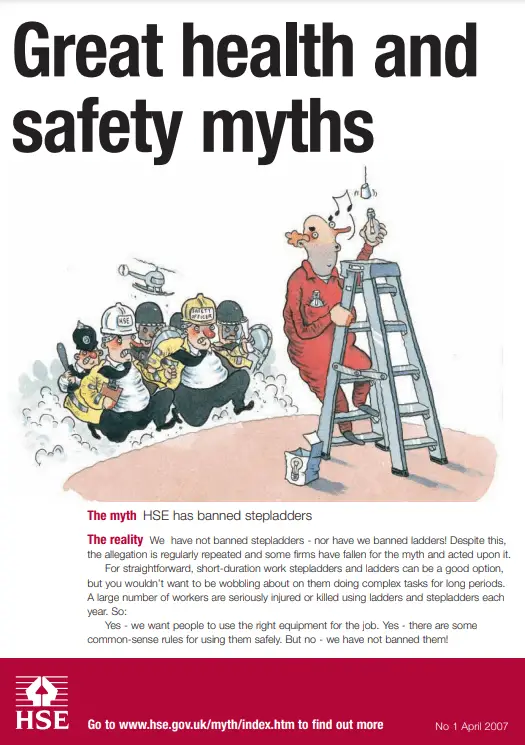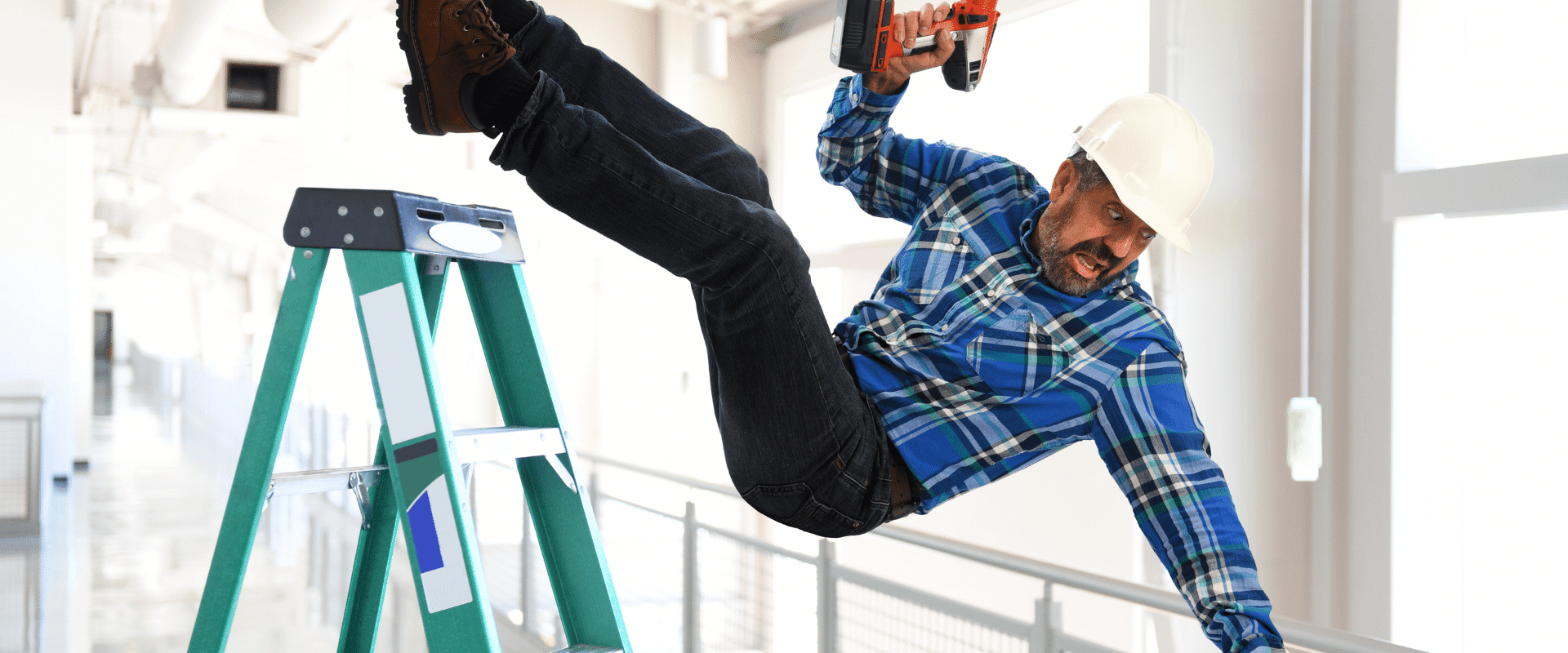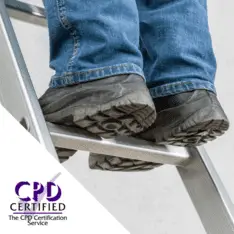Are step ladders banned from construction sites? The straight forward and resounding answer to this common question is NO, the HSE has not banned the use of step ladders and ladders from construction sites or anywhere else for that matter where a risk assessment has determined they are the most appropriate thing to use for the task in hand.
In fact, the myth gained so much momentum that the HSE produced it’s own poster and statement.
“We have not banned stepladders – nor have we banned ladders! Despite this, the allegation is regularly repeated and some firms have fallen for the myth and acted upon it.
For straightforward, short duration work stepladders and ladders can be a good option, but you wouldn’t want to be wobbling about on them doing complex tasks for long periods. A large number of workers are seriously injured or killed using ladders and stepladders each year.
Yes – we want people to use the right equipment for the job.
Yes – there are some common-sense rules for using them safely.
But no – we have not banned them!”

What Does the Ladder Association Say?
An article on the Ladder Association website states that former HSE Chief Executive Geoffrey Podger said it best: “Let me be clear, ladders are not banned, and HSE has been saying this since 2005. Despite that, HSE’s Infoline still gets regular calls asking whether ladders are banned, so the rumour won’t go away.
“There will be circumstances when a risk assessment concludes that a ladder is not the right sort of access equipment for a particular job, but this is not the same as saying ladders are banned. The HSE will continue to make this point publicly alongside the Ladder Association which promotes safe and responsible ladder use.”
When is a ladder the most suitable choice?
In all things, the law calls for a sensible and proportionate approach to managing risk. Ladders can be used for working at height when a risk assessment has determined that it is not justified to use other safer working at height equipment. This is usually due to the task being low risk and of short duration. (or there are workplace features that cannot be altered).
However, short duration shouldn’t be regarded as the deciding factor in using a ladder. The risk of fall should be the first consideration, and certainly where the ladder cannot be placed on even ground, where the angle is too severe, where the user has to reach over to the task from the ladder, or where the task itself is going to take any longer than 30 minutes.
In any of those situations, your first thought should be to use safer working at height alternatives.
Who can use a ladder?
To use a ladder, you need to be competent. That is to have had instruction and understand how to use the ladder safely, and what to be aware of.
Training is often on the job. However, the person supervising should be able to also perform the task competently. Anybody who is inexperienced (especially young people) need to be supervised at all times.
Check your ladder before use.
Before carrying out any task from a ladder or step ladder, it should be checked before use. This is particularly important if it is not your own ladder or is shared among various workers, and it should include a pre-check.
- Checked by the person using it.
- At the beginning of the working day, or on first use of the day.
- If something has changed, such as its general condition (being used in a muddy or wet environment), or if it has been dropped, knocked over, struck by a vehicle etc.
Following on from that, carry out the following checks:
- Check the feet. Are they missing, worn, damaged, dirty, oily, or embedded with stone chips. Could they cause the ladder to slip?
- Check the stiles. Check they are not damaged or bent in any way that could cause the ladder to buckle under your weight.
- Check the rungs. Are they showing any signs of damage or giving way?
- Locking mechanisms. Can they engage freely, Are they damaged or missing?
- Check treads or steps on stepladders. Are they properly fixed, do they have contamination such as grease, mud or water that will make them slippery.
- Stepladder platform. Is it damaged, bent or cracked in any way that could cause the stepladder to collapse.
Any damage or defect would require you to take the ladder out of service and have it repaired or replaced. Do not attempt to use it, or let anyone else use it. (Even if they insist it’ll only be for 2-minutes!)
Minimise the risk of fall from a ladder.
Once your checks are all complete and satisfactory, understand the simple precautions you can take to prevent a fall.
- Only carry light tools and light materials up the ladder.
- Don’t overreach from the ladder. Stay within the stiles, and if you find you have to reach over to carry out the task then come down and move the ladder.
- Ensure that the ladder comfortably reaches the task. Don’t be tempted to access the top 3 rungs under any circumstance to reach the task. Get a bigger ladder, or arrange alternative safer work at height equipment.
- Use the 1 in 4 rule when leaning a ladder against a wall. (1 unit out for every 4 units up. Or an angle of 75-degrees)
- Always keep a good grip on the ladder while ascending or descending, and never slide down the stiles.
- Do not try to move the ladder or extend it while stood on it. Get down and move it safely.
- Ladders should always be stood on solid level ground, never anything that can move such as bricks, pallets, tower scaffolds, moving elavating platforms, vans, flat bed trucks etc
- Maintain 3 points of contact when climbing, and at the work position wherever possible. (a hand and two feet). Where you cannot maintain a handhold for more than a brief moment consider an alternative safer method of working.
- For a leaning ladder have a strong flat resting point, avoiding things like plastic gutters or facia boards, and secure the ladder by tying to prevent outward and sideways movement. Also consider the use of upper and lower stability devices.
When using a stepladder.
- Check all four feet are in contact with the ground.
- Check the steps are level, clean and in good condition.
- Only use stepladders for lightweight jobs.
- Don’t overreach.
- Avoid standing on the top three steps unless there is a suitable extended hand hold rail.
- Where possible position the stepladder to work face on rather than sideways on where exerting pressure (i.e. drilling a wall) may cause you to topple the stepladder. (Side loading).
- Maintain 3 points of contact in the working position
Ladder standards.
In the workplace or on any building or maintenance site, the use of domestic ladders of any sort is forbidden. Remember, domestic ladders and step ladders are just that, to be used very occasionally in a domestic situation. They are much lighter than commercial ladders and have a much lower weight tolerance.
If you are providing or using ladders in any workplace or commercial situation then your ladder or stepladder must meet or exceed the requirements of EN131 which has replaced the BS2037 and BS1129 standards.
The HSE guidance document for ladders and stepladder use, INDG455, has now been superceeded by LA455 which is a safety guide produced in conjunction with the HSE and The Ladder Association.
Do You or Your Staff Require Ladder Awareness Safety Training?
This ladder safety course is perfect for people who carry out tasks on ladders or stepladders. You will explore why ladders are dangerous and look at the hazards that are associated with their use. You will also look at correct procedures to ensure ladders are used safely.
All our e-learning courses are in conjunction with the Online College and are CPD accredited, easy to use and incredibly affordable.

